Assembling a Life: Several Dozen New Fragments on Moshe b. Levi ha-Levi
The letters of the Genizah are among the most accessible documentary sources, offering tantalizing but ambiguous glimpses into private lives. Certain individuals threw large quantities of their correspondence into the Genizah—the merchant Nahray b. Nissim, for instance, or the judge Eliyyahu and his family. For obvious reasons, the Genizah characters who have received the most attention in the scholarly literature are those who tended to sign and address their letters. But there are also scores of writers whose identities remain veiled until a researcher becomes curious, conducts a dogged investigation, and has a good deal of luck.
This Fragment of the Month is about one such writer and the dozens of letters and fragments he left behind him: Abū l-Bayān Moshe b. Levi ha-Levi, a contemporary and sometime correspondent of Moses Maimonides. I build on Amir Ashur’s two prior Fragments of the Month about the same person (April 2011 and November 2016) and on his discovery that the Joins Suggestion algorithm on the Friedberg Genizah Project (FGP) can yield a large network of interconnected letters when a writer has highly distinctive handwriting, as Moshe and his family members do.
Through a combination of obsession and serendipity, I have assembled some 80 Genizah documents pertaining directly to Moshe b. Levi. Approximately 50 were written by him and approximately 15 each by his brother and his father. Some are completely unstudied, while others have received plenty of attention—but typically as the work of Anonymous, in isolation from the remainder of the corpus. In this Fragment of the Month, I hope to demonstrate some of the ways these scattered pieces can combine to create a portrait of a hitherto obscure figure.
Moshe’s main claim to fame is that he was, for some years, the head (muqaddam) of the Jewish community in Qalyūb, a small town about 10 miles down the Nile from Fusṭāṭ. The job description was multifarious: he served as chief cantor, slaughterer, and liaison between the community and the Head(s) of the Jews. On the side of these communal offices, he ran a brisk drug business[1] and dabbled in the book trade.[2] His brother (Abū l-Ḥasan Yedutun) and his father (Abū Sahl Levi) were cantors in the Palestinian synagogue of Fusṭāṭ (i.e. the home of the Genizah).[3]
For the last 120 years, Moshe has cropped up in diverse places in Genizah scholarship. As he seldom bothered to sign his letters, he is rarely identified by name. S. D. Goitein writes, for instance, “One [druggist from the Rīf], in whose hand I have noted three such letters, also had scholarly interests, not unusual among members of his profession.”[4] Jacob Mann, Alexander Scheiber, and Hayyim Schirmann all published some fragments by Moshe b. Levi, though they did not necessarily draw connections between their fragments and others (and Mann also mistook his name for Moshe b. Eliyyahu).[5] Shulamit Elizur is the one who identified the family relationship between Moshe and his brother Abū l-Ḥasan Yedutun ha-Levi.[6] Oded Zinger also edited a letter by Moshe in his dissertation, and Amir Ashur later identified the writer in a discussion on Facebook.[7]
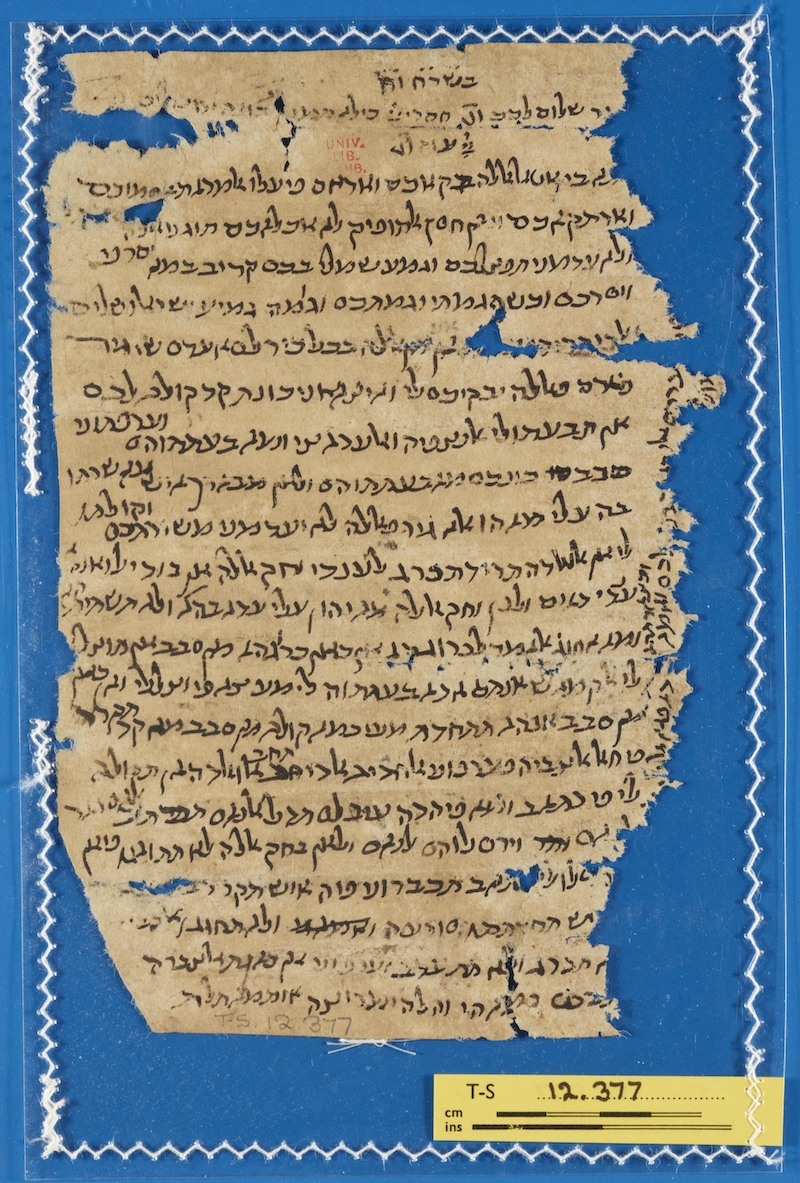
T-S 12.377, recto
I became interested in Moshe after sinking several hours into deciphering the lines about his sister’s illness in T-S 12.377. Trying to dissuade his mother from paying a visit, he writes, “If she wants to tell me about the condition of the girl, just tell me whatever she wants to say in a letter. There is no shame in that. People are used to writing the secrets of people in letters and sending them” (lines 17–20).
Since I work on representations of illness in Genizah letters, I naturally wanted to turn up more examples from this man who had such a lax attitude toward patient privacy. I went down a rabbit hole of iterative Joins Suggestion searches, along with text searches on both FGP and the Princeton Geniza Project (PGP) of some of the names, phrases, and unique misspellings that recurred in the letters I had already found.[8] I emerged with dozens of candidates for letters—and even more literary fragments—by the same man.
For the full list, I direct the curious reader to PGP, where clicking on the “Moshe b. Levi” tag will bring up approximately 50 documentary fragments either in his hand or involving him as a central character. (There are also tags for his brother “Yedutun ha-Levi” and his father “Abu Sahl Levi.”) Amir Ashur gets the credit for introducing some of the most interesting ones to the FOTM readership. For example, DK 173 is an autobiographical work in rhymed prose (maqāmah), in which Moshe narrates the twists and turns of his early career and the plight of having to move back in with his parents, until he could move out for good and set up a life in Qalyūb. Ashur also discusses Moshe’s panegyrics for various dignitaries, Maimonides among them, and a legal query in Moshe’s hand with an autograph responsum by Maimonides.[9]
In this FOTM, I present a series of letters about an episode in Moshe’s career when his status as muqaddam was in jeopardy, probably in 1195 CE. (As far as I know, this is the first time anyone has analyzed these letters as a group.[10]) Moshe ultimately triumphed, but not before having to scramble to appease the Gaon Sar Shalom ha-Levi (no relation), who served as the Head of the Jews in the Ayyūbid Empire, 1173–95.[11] I then suggest other areas of special interest in the Moshe corpus, and I conclude with an account of the death of Moshe and of his father Abū Sahl Levi, based on two poems and a tragic letter all written by his brother Yedutun.
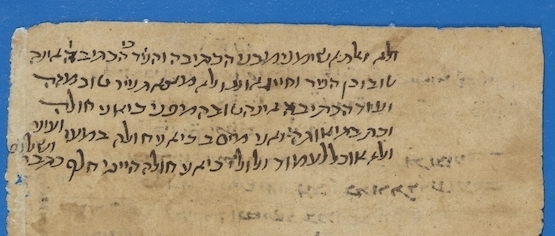
T-S 13J20.18, verso
Early in my quest to accumulate Moshe fragments, I discovered that I was already familiar with one that he had written about his own illnesses:
Don't do not [ve-lo ve-al] hold me accountable bor [״מבני״ for ״מפני״] the writing and the paper, because the writing is not good and neither is the paper. By the life of our Gaon, I could not find paper better than this. Also, the writing is not good because I am sick. I wrote it lying down, because I am sick in my intestines and my eyes, and I cannot stand. If I were not sick, I would be [there] in place of my letter. And peace.
This is from the postscript of T-S 13J20.18, a Hebrew letter addressed to Sar Shalom. Why did he have to write an obsequious letter to the Head of the Jews? In the body of the letter, after an original poem in praise of Sar Shalom, he lays out his case.
A suspicious physician named Yefet b. Shelomo, known as Ibn al-Ṭaffāl (“son of the fuller”), had shown up in Qalyūb claiming that Sar Shalom had appointed him the exclusive circumciser for “all the villages” of the countryside. Moshe examined his letter of appointment, could not find Sar Shalom’s distinctive mark, and announced that the letter was counterfeit, thereby earning the animosity of Ibn al-Ṭaffāl. Now, Moshe hears that Ibn al-Ṭaffāl has been slandering him to the Gaon by claiming that Moshe has been undermining his authority. The purpose of this letter is to beg for mercy. Sar Shalom must not believe what he hears, and, further, who is Moshe that Sar Shalom should be angry at him? “After whom is the king of Israel come out? [after whom dost thou pursue? after a dead dog, after a flea]” (1 Samuel 24:14).
The scandal of Ibn al-Ṭaffāl echoes through a number of letters between Moshe and his family members. He writes in Arabic to an informant in Fusṭāṭ, presumably his father or brother, pleading to be updated on Ibn al-Ṭaffāl’s fortunes (ENA NS 68.11r, lines 5-10). He gloats over how Ibn al-Ṭaffāl had to (or will have to) retreat from Qalyūb with his tail between his legs: “He should be treated the way I would treat a fool of his ilk, by being beaten and degraded and moved from Qalyūb to Fusṭāṭ.”[12] (This reading is somewhat tentative, and I would be grateful for a second set of eyes on the Arabic.) Moshe adds that he would prefer not to have to leave Qalyūb himself.
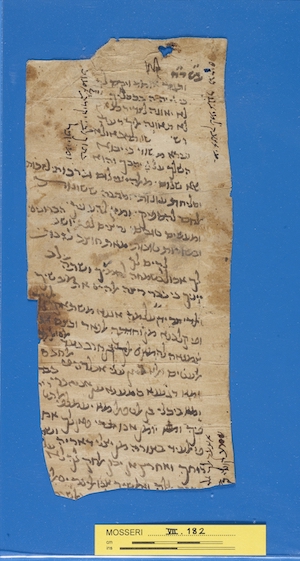
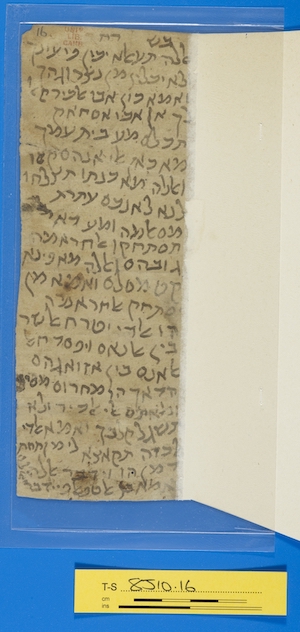
Mos.VII.182, recto
T-S 8J10.16, verso
Moshe’s family indeed kept him informed. His brother Yedutun writes in Mos. VII.182, “We haven’t heard any more news about Abū Zikrī [Sar Shalom]. Ibn al-Ṭaffāl continues with the […] against you, but Abū Zikrī doesn’t believe him” (lines 21–23).[13] Ultimately, intestinal and ocular illnesses notwithstanding, Moshe had to make the trip to Fusṭāṭ and appear in person before Sar Shalom. In T-S 8J10.16, he writes that he has safely returned to Qalyūb, and that the community rejoiced when he told them what had happened. He asks his father to ask a certain Abū ‘Alī to intercede with Sar Shalom and obtain the “letter of appointment” (lines 6–7). Evidently Sar Shalom had promised such a letter but needed to be pestered to actually issue it. Moshe’s father responds on verso and concludes, with a menacing-sounding blessing, “As for Ibn al-Ṭaffāl, may God sort him!” (line 23).
ENA 4020.4 may be the hoped-for letter of appointment. In it, Sar Shalom addresses the esteemed community of Qalyūb, declaring that “Moshe ha-Ḥazzan ha-Yaqar b. Levi ha-Ḥazzan ha-Yaqar Ahuv ha-Yeshivah” is more qualified than anyone else in terms of his expertise in the laws of slaughter and leading prayers. The letter continues, “He was only hindered in performing his duties because of his illness. You are to obey and keep his rulings, for he is the one who teaches your children Torah and through whom you will fulfill your obligations” (lines 11–16 and margin).
It is tempting to regard all these letters as belonging to the same chapter of Moshe’s career. We only know his version of the events, but we can plausibly reconstruct them as follows. Moshe had already been serving as the muqaddam of Qalyūb, leading their prayers and slaughtering their livestock, when he lost the favor of Sar Shalom. This may have been due to the malign influence of Ibn al-Ṭaffāl, or because a challenger for the position arose, or because Moshe was detained in fulfilling his duties due to his illness. This last possibility became the official story when, through his own advocacy and the help of allies in the capital, he succeeded in gaining a letter of (re-)appointment and returning to his former position. However, as none of the documents are dated, this synthesis remains tentative.
A final document that illuminates the communal politics of Qalyūb in this era—and the election and qualifications and duties of a muqaddam in general—is PER H 93. This is a legal testimony recorded in Moshe b. Levi’s best handwriting, describing events that took place on the 7th of Av, a Shabbat, in 1195 CE (1506 by the Seleucid calendar), near the end of Sar Shalom’s tenure as Head of the Jews.[14]
The community had gathered to pray behind Moshe b. Levi (here called Mūsā b. al-Ahuv), when someone arrived and announced, “Know that Yiẓḥaq the Sicilian[15] is trying to return to you. If you desire him over Mūsā b. al-Ahuv, then tell Mūsā b. al-Ahuv to leave. But if you desire Mūsā b. al-Ahuv over all others, then declare that no one else will serve as your muqaddam” (lines 8–15). The community declared “as one” that they desired only Mūsā b. al-Ahuv, due to his learning and dedication to their service, and his religion and his compassion. They will not give their money to any other muqaddam, nor pray behind another, nor eat the meat another slaughters, nor accept anyone else, whether by Jewish law (bi-wajh al-shar‘ī [sic!]) or the law of the land (bi-wajhin sulṭānī). The names of ten elders and three signatures follow.
There is a great deal more to be discovered in the correspondence of Moshe and his family members. Some areas of special richness are as follows.
- I will be grateful to anyone who can shed light on the domestic strife swirling around the wife of Moshe’s paternal uncle (probably ‘Imrān), to which Oded Zinger was the first to draw attention. Moshe seems to have had a central but unclear role in the conflicts and in mediating them.[16]
- The corpus would be valuable for anyone interested in tracing the operations of a druggist who lived close enough to the commercial emporium of Fusṭāṭ to access all manner of materia medica.[17] Or for anyone interested in local economies and markets: the most common subject in Moshe’s letters is small transactions (not just in pharmaceuticals) and transfers of money.
- Moshe’s family members frequently discuss the poll tax and how they will manage to pay it.[18]
- There is much more to be understood in terms of Moshe’s relationships with multiple Heads of the Jews and communal dignitaries, including both Moses Maimonides and Abraham Maimonides in addition to Sar Shalom. Some of Moshe’s legal queries, for example, received autograph responsa by Moses Maimonides; there are also several more whose answers are not preserved.[19]
- The family network could be mapped further. For instance, Goitein identifies his father, Levi, as Abū Sahl b. Moshe, but I suspect he was actually Abū Sahl b. Ibrāhīm (as Elizur has also suggested).[20] Another open question: was Yedutun a physician?[21]
- More of Moshe’s Arabic letters could be found, and it would be interesting to learn when and why he used Arabic vs. Hebrew vs. Judaeo-Arabic.[22]
Similarly, in terms of charting the entire Genizah footprint of a certain person or group of people, it is worth considering that Moshe and his father Abū Sahl and his brother Yedutun were all cantors associated with the Palestinian synagogue of Fusṭāṭ at one time or another. As cantors, they churned through a vast amount of paper, composing and exchanging and editing liturgical poetry (piyyuṭ). The ~80 letters and documents pertaining to these individuals appear to be a small portion of what they left in the Genizah. However, the identification of literary fragments in their handwriting is a more tenuous proposition, since it rests purely on analyzing handwriting rather than finding common themes and names and phrases. I would be happy to share a list of literary fragments that may have been copied or composed by these individuals with anyone interested.
But, of course, it is misleading to speak of the ‘documentary’ and the ‘literary’ as non-overlapping subsets of Genizah fragments. This is especially true when the scribe of a ‘literary’ fragment is known. Elizur has shown as much in her collection and analysis of the poetry of Moshe’s brother Yedutun ha-Levi, including two moving elegies that he wrote upon the death of Moshe and upon the death of their father Levi.[23] Though each elegy is ostensibly for a single person, Elizur points out that each contains a central ambiguity: how many people have died?
For his father Levi:
Mourners gathered round for my sorrow and grief,
For the ruin of my temple, for my nation dispersed.
My master and father—o woe—this year were lost,
My Judge, my Levi, my lord, whose mercies have left me.
See, God, my distress; my entrails burn within me.[24]
For his brother Moshe (note that “father” in line 3 could be a respectful term for an elder brother, as Elizur suggests):
Song, incense, and sacrifice have deserted the temple,
For this I cry out loud, and for my forsaken masters,
My elder and father Moshe, and my Judge who fell
In the harsh snare of death, for these I spill tears.
Death, the creditor, claimed them, as one who strikes his brother.
See, God, and consider whom you have so afflicted.[25]
These ‘literary’ elegies, even apart from their poetic merit, provide ‘documentary’ information that would be difficult to glean from letters, regarding the affective bond between Yedutun and his family members. I will conclude, in turn, with a ‘documentary’ letter that illuminates the content of the poems.
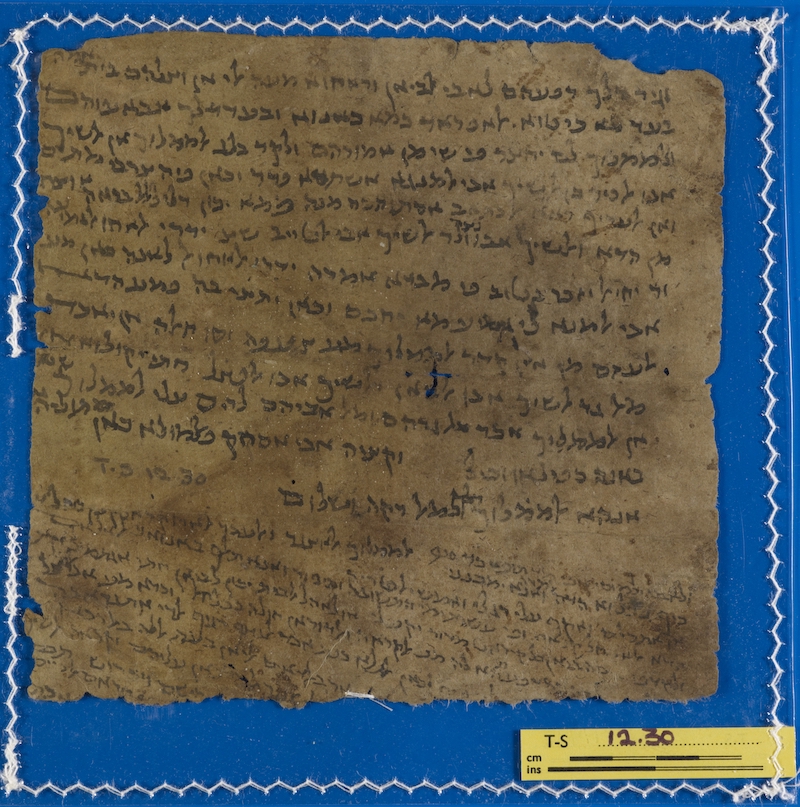
T-S 12.30, verso
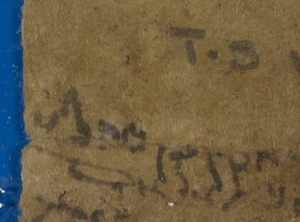
Signature of [Abu I-] Hasan b. [Abu] Sahl, detail of T-S 12.30
This letter, T-S 12.30, composed circa 1236 CE, belongs to another class of under-studied Genizah fragments: those that are just faded enough to be legible with prolonged squinting, but which have rarely seemed worth the effort. With Goitein’s partial transcription as the basis, I have filled in most of the rest of the transcription on PGP. The handwriting is that of Yedutun, and the hypothesis that he is the writer receives confirmation with the signature: “[Abū l-]Ḥasan b. [Abū] Sahl.”
Yedutun provides a detailed explanation of the funeral and financial arrangements following the death of his father Levi and his brother Moshe, aiming to exonerate himself from the accusations of Abū l-Bayān and Abū l-Faḍl (from context, the sons or grandsons of Moshe) that he “took the property of their father and grandfather.”
He writes the following:
- Abū Sahl Levi died on the 24th of Tishrei, 1211 CE. Moshe and Isḥāq—perhaps their other brother, Abū Isḥāq—executed his will (lines 1–3).[26]
- Moshe b. Levi lived only five months after that, dying on the 20th of Adar, 1212 CE. Rav Yosef ha-Nezer and his [brother?] Abū l-Mufaḍḍal the Judge executed the will of Moshe (lines 9–11).
- The Judge—probably the same Abū l-Mufaḍḍal—died about two months after Moshe (lines 16–17).
Yedutun continues with a granular account of a divorce (his?) and the disposition of property, household goods, and money. He repeatedly refers to his own illnesses, claiming that he was too ill to have had any part in managing the estates, let alone steal more than his share. He writes in a melancholy postscript, “It has been 24 years since my brother Musa died. [If there is substance to their claims,] how have they ignored this matter for all this time?. . . Every penny that falls into my or my wife/family’s hands goes to [Abū l-]Bayān. . . and it is the same with Abū l-Faḍl.”
Yedutun’s memory of the deaths and the funerals was still clear two decades later, suggesting that his grief remained an open wound, and one surely worsened by his nephews’ accusations of foul play. With the factual information from his letter of 1236 CE, we can return to the year 1212 when he composed his elegies. His tone of devastation, conflating his personal grief with Israel’s grief over the loss of the Temple, becomes all the more understandable when we realize that his grief was multiple: in a single year, he lost “a Judge,” his “elder and father,” and his “Moshe.”
Acknowledgments:
Thank you to Ben Outhwaite for encouraging me to write this FOTM and for several helpful suggestions.
Thank you to Amir Ashur for paving the way in Moshe Studies and for several helpful suggestions and excellent catches on my first draft.
Thank you to Marina Rustow, Eve Krakowski, Ben Johnston, and Deena Abdel-Latif for their tremendous recent work on the Princeton Geniza Project.
Thank you to the Inquiry program of the University of California, San Francisco for providing a yearlong fellowship for me to research and write a paper on representations of illness based on Genizah fragments.
Bibliography:
Ashur, Amir. “A poet for all seasons, T-S Misc.25.24 and T-S Misc.8.90.” Cambridge University Library, Genizah Research Unit Fragment of the Month, April 2011.
—. “On the identification and biography of the ‘poet for all seasons’ and his contact with Maimonides: T-S 10K8.3, T-S 8K13.8 and T-S NS 264.98.” Cambridge University Library, Genizah Research Unit Fragment of the Month, November 2016.
Elizur, Shulamit. “Individual Mourning and National Solace in Early Liturgical Poetry.” Ginzei Qedem 7 (2011), 16–24.
Friedman, Mordechai Akiva. “Maimonides and Zuta: A Tale of Three Bans.” Zion 74 (2005): 473–527.
Goitein, S. D. A Mediterranean Society: the Jewish communities of the Arab world as portrayed in the documents of the Cairo Geniza. Berkeley: University of California Press, 1967–93.Mann, Jacob. The Jews in Egypt and in Palestine Under the Fatimid Caliphs. Oxford: Oxford University Press, 1920.
Olszowy-Schlanger, Judith. “Petit guide de description des écritures hébraïques : identifier la main du scribe.” http://www.hebrewmanuscript.com/images/petit-guide-de-description-des-ecritures-hebraiques-bwb.pdf
Russ-Fishbane, Elisha. Judaism, Sufism, and the Pietists of Medieval Egypt. Oxford: Oxford University Press, 2015.
Rustow, Marina. “Sar Shalom ben Moses ha-Levi.” In: Encyclopedia of Jews in the Islamic World. Executive Editor Norman A. Stillman. Consulted online on 20 April 2020. First published online: 2010.
Scheiber, Alexander. Geniza Studies. New York: G. Olms, 1981.
Schirmann, Hayyim. New Hebrew Poems from the Genizah. Jerusalem: ha-Akademyah ha-le’umit ha-Yissreʼelit le-madaʻim, 1965.
Zinger, Oded. “Women, Gender and Law: Marital Disputes According to Documents from the Cairo Geniza.” PhD diss. (Princeton University, 2014).
Footnotes
[1] On Moshe as a druggist, see AIU VII.E.158, ENA 2558.18v, ENA 2808.41, ENA NS 67.8, ENA NS 7.81, T-S 10J17.12, T-S 10J17.3, T-S 13J27.21, T-S NS 107.13, and T-S NS 264.55.
[2] A book list in his hand: T-S K3.41. Two drafts of a letter to a certain distinguished physician, also named Moshe, who was both employer and host to Moshe b. Levi. Our Moshe writes to Dr. Moshe apologizing for running away: it was simply too mortifying to have to constantly ask Dr. Moshe for water with which to wash his hands. Moshe b. Levi now wishes to settle accounts for three Talmudic tractates for which Dr. Moshe still owes him money: T-S 6J10.9 and T-S Misc. 28.140, ed. Alexander Scheiber, Geniza Studies, New York: G. Olms, 1981, 342–47. Scheiber gives in to the temptation to assume that Dr. Moshe must be Maimonides, and in truth Moshe b. Levi’s flattery is so florid that it seems worthy of Maimonides. But I thank Amir Ashur and Ben Outhwaite for bringing to my attention that this is quite unlikely: Moshe b. Levi blesses the “sons” of Dr. Moshe, and Maimonides had only one son. For the suggestion that Moshe b. Levi did not know the number of Maimonides’s sons (or included the hypothetical daughter of Maimonides in the count), see Elisha Russ-Fishbane, Judaism, Sufism, and the Pietists of Medieval Egypt, Oxford: Oxford University Press, 2015, 9–10 (n. 20). But Moshe b. Levi had been staying in the home of Dr. Moshe, and, as Ashur pointed out to me, he blesses the right number of sons of Maimonides (one) in ENA 1810.2. While on the subject, these letters from Moshe b. Levi to Dr. Moshe contain a curious citation from the Qur’ān, whether intentional or because the expression had entered everyday speech. Moshe writes, “Your slave is not crazy (shoṭeh) to say something and not to do it” (T-S Misc. 28.140, r26–7; T-S 6J10.9, r10–11). This is verbatim how the Qur’ān characterizes the poets, “upon whom the devils descend. . . . Do you not see that in every valley they roam, and that they say what they do not do?” (26:226).
[3] See T-S NS J323 (by Yedutun) and T-S Misc. 23.6 (by Moshe, in which he also claims his grandfather and great-grandfather and paternal uncle are/were cantors).
[4] S. D. Goitein, A Mediterranean Society: the Jewish communities of the Arab world as portrayed in the documents of the Cairo Geniza, Berkeley: University of California Press, 1967–93, II:270.
[5] Jacob Mann, The Jews in Egypt and in Palestine Under the Fatimid Caliphs, Oxford: Oxford University Press, 1920, II:300–01. Scheiber, Geniza Studies, 342–47. Hayyim Schirmann, New Hebrew Poems from the Genizah, Jerusalem: ha-Akademyah ha-le’umit ha-Yisreʼelit le-madaʻim, 1965, 377–84.
[6] Shulamit Elizur, “Individual Mourning and National Solace in Early Liturgical Poetry,” Ginzei Qedem 7 (2011), 16–24.
[7] Oded Zinger, “Women, Gender and Law: Marital Disputes According to Documents from the Cairo Geniza,” PhD diss., (Princeton University, 2014). Zinger’s document #8 (T-S 8J10.16) is a letter by Moshe with the response by his father Abū Sahl on verso. See the discussion on https://www.facebook.com/cairogenizamicrohistory from 15 Sept. 2019. Zinger’s document #5 (T-S 6J3.17) and his suggested match (Mos. IV.27.2) are both in the hand of Moshe’s brother Yedutun; the latter is to Moshe, and the former may be as well.
[8] A brief methodological note: the identification of writers on the basis of handwriting is far from an exact science, though it might approach one with a rigorous application of Judith Olszowy-Schlanger’s “Petit guide de description des écritures hébraïques : identifier la main du scribe,” http://www.hebrewmanuscript.com/images/petit-guide-de-description-des-ecritures-hebraiques-bwb.pdf. Among the many distinctive (though not necessarily unique) elements of Moshe’s handwriting: polymorphous alephs, often three different shapes in the span of a few lines; tavs that look like dalets or even qofs; ligatures of -tū and -nī suffixes; wobbly baselines; a special mark that he was fond of placing at the top of his documents; and use of a large script, with only ~6 words per line. For more on the interpretation of what has been called the "mysterious sign," see Zinger, Women, Gender, and Law, 344–45 and the sources cited there, including Goitein and Friedman, India Traders of the Middle Ages, Leiden: Brill, 2011, 506–07. But evidence beyond penmanship is often more compelling: he tended to use paper of the same dimensions; he relied on the repetition of a handful of phrases (e.g., min kull budd, sūr‘ah, fa-tfaḍḍalū ‘arrifūnī / sayyirū lī); and the names of a small number of people and commercial goods recur throughout the corpus. A confounding factor is that Moshe had a spectrum of handwritings: he wrote letters and legal queries to important people as neatly as he could manage (e.g. T-S 6J10.9), while he had a hasty scrawl for his family members (e.g. T-S 10J17.3). I have tried to err on the side of caution and exclude any document for which handwriting is the only element linking it to other documents in the corpus. There is one helpful misspelling which serves to unite two different subsets of the corpus: he writes ״השאובה״ instead of ״השואבה״ (in the context of Sukkot) in both T-S 8J24.17 (a hasty Judaeo-Arabic letter to a family member) and T-S 13J20.18 (a formal Hebrew letter to the Head of the Jews).
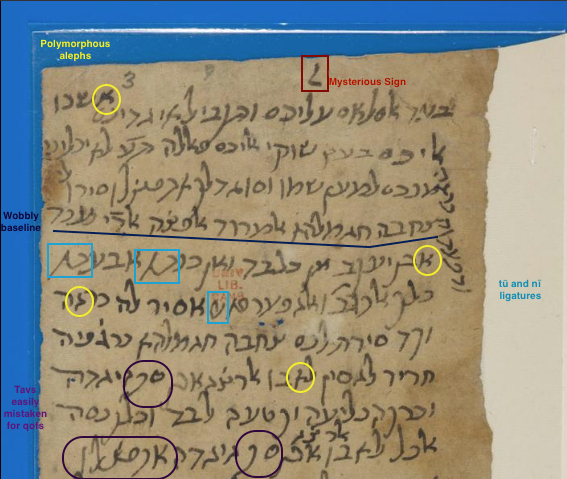
[9] T-S 10K8.3 + T-S 8K13.8, edited by Joshua Blau.
[10] Mordechai Akiva Friedman has discussed a subset of them in the context of his study of Sar Shalom ha-Levi (alias Zuta): T-S 10J17.19 (a letter of recommendation for Moshe who needs help paying his poll tax); PER H 93 (a legal attestation that the people of Qalyūb (re-)elect Moshe as their muqaddam); and ENA 4020.4 (in which Sar Shalom issues a letter of (re-)appointment for Moshe as muqaddam). Mordechai Akiva Friedman, “Maimonides and Zuta: A Tale of Three Bans,” Zion 74 (2005): 488-489, 514-515, and notes 210–13.
[11] Sar Shalom also had a previous tenure from 1170–71; Moses Maimonides was Head of the Jews from 1171–73 and from ca.1195–1204. Marina Rustow, “Sar Shalom ben Moses ha-Levi,” in: Encyclopedia of Jews in the Islamic World, Executive Editor Norman A. Stillman. Consulted online on 20 April 2020. First published online: 2010.
[12] I read: ويتعمله كما اتعمل بحمقا (؟) كهو مثله بضربه واهانته وتغييره (؟) من قليوب الى مصر.
[13] The missing word, which starts with תט, is probably legible. Others should take a look.
[14] Mordechai Akiva Friedman observed (in 2005) that this is the latest known dated document that refers to Sar Shalom as the current Head of the Jews. He also points out, compellingly, that Sar Shalom was responding to this document when he issued ENA 4020.4, the letter of appointment for Moshe. Though the full date of ENA 4020.4 is not preserved, the month Av is preserved, which makes it plausible that PER H 93 and ENA 4020.4 were written in the same month. See footnote 10 for the references to Friedman’s work.
[15] See T-S 10J18.11 for another probable reference to Yiẓḥaq the Sicilian. The left half of recto is missing, but line 4 picks up “. . . the Sicilian, may God bring him low [nakabahu Allāh].”
[16] See T-S 8J10.16 (Zinger’s document #8, in which there is a rumor that Moshe’s brother Abū Isḥāq has been beating the wife of their paternal uncle) and Mos. IV.27.2 (Zinger’s translation: “Your paternal uncle, ‘Imrān, is complaining. All sorts of nastiness took place between him and his wife because of you”). T-S 8J24.17 and ENA NS 68.11 both mention the wife of a paternal uncle, and we learn from T-S 13J27.21v that Moshe gave financial support to the daughter of a paternal uncle. Most titillating of all is AIU VII.E.158, in which Moshe tell the addressee—probably his father—to find a certain Ismā‘īl who has a book stashed with Ibn al-[[rubbed out]]. Ismā‘īl has told Moshe that it has “chapters on love [spells?!].” The addressee is meant to retrieve the book and to “do them” to various women in the family of Moshe's paternal uncle, including the uncle’s wife, his mother, and her daughter (verso, lines 5–12). A novel approach to resolving family conflict?
[17] See footnote 1.
[18] See CUL Or.1081 J14 + T-S AS 145.195, T-S 8J23.5, T-S 12.414, and T-S 10J17.19 (may be a letter of recommendation for Moshe who needs money for his poll tax).
[19] See footnote 8. More legal queries that appear to be in his hand (most found by Amir Ashur): BL Or. 5563D.11 (published by Freimann and Goitein in their edition of the responsa of Abraham Maimonides, nos 122–123); ENA 2558.31c; ENA 2808.20; JRL Series B 3819; JRL Gaster 1861/2; T-S AS 152.22, and T-S G1.24.
[20] Goitein, Med Soc, vol. VI, p. 6, under Abū Sahl ha-Levi b. al-ahuv and Abū Sahl b. Moses. The documents indexed include T-S 10J26.7, Bodl. MS Heb. d.66/45, ENA 2591.18, T-S NS 320.41, and L-G Arabic I.49. But the father of Abū Sahl the cantor is not identified in any of these fragments. Goitein seems to have equated this Abū Sahl with the Abū Sahl b. Moses addressed in T-S 8J16.7 (a conjecture which may yet prove true). But see Elizur, “Individual Mourning,” 22. She cites Bodl. MS Heb. a.2/9, a will signed by Levi ha-Levi b. Avraham in 1188.
[21] Elizur draws attention to L-G Misc. 99, which says in large calligraphic letters, “I wrote this, Yedutun ha-Levi ha-Rofe [the physician] b. Levi ha-Levi.” This would seem to answer the question in the affirmative, except for the lack of corroborating evidence. But there is some evidence in Arabic, which might also resolve the question of the name of Abū Sahl’s father. T-S NS 305.115, edited by Geoffrey Khan, preserves three drafts of a testimony concerning the qualifications and good conduct of the physician Abū l-Ḥasan b. Abū Sahl b. Ibrāhīm (information from CUDL). And CUL Or.1080 J117v contains two addenda to a property deed, probably written a century after the original deed (dated 1088 CE). Above, Abū Sahl b. Ibrāhīm makes a gift of the house to his son Abū l-Ḥasan the physician. Below, Mūsā b. Abū Sahl rents part of it from his brother Abū l-Ḥasan. (Information from Goitein, Med Soc, III:479.) Given the exact concordance of the family members’ names, it seems very probable that this Abū l-Ḥasan is identical with Yedutun, and that he was both cantor and physician.
[22] Three Arabic letters either written by Moshe or sharing the same piece of paper as letters by him: ENA NS 68.11 (letter mentioning Ibn al-Ṭaffāl); T-S 10J17.12 (contains a draft of an Arabic petition); T-S K25.43 (wheat accounting).
[23] Elizur, “Individual Mourning,” 16–24.
[24] T-S NS 135.3b (Elizur’s edition, my rough translation).
[25] T-S NS 325.135 (Elizur’s edition, my rough translation).
[26] “Executed his will” may not be a precise translation. According to Joshua Blau’s Dictionary of Medieval Judaeo-Arabic, tawallā amrahu would mean “took care of his affair.” Perhaps it just means “took care of the funeral.” The verb tawallā also means “redeem,” in a technical sense, but I am not sure what sort of redemption would be intended here.
Cite this article
Elbaum, A. (2020). Assembling a Life: Several Dozen New Fragments on Moshe b. Levi ha-Levi. [Genizah Research Unit, Fragment of the Month, April 2020]. https://doi.org/10.17863/CAM.65548
If you enjoyed this Fragment of the Month, you can find others here.
Contact us: genizah@lib.cam.ac.uk
The manuscripts in this article are included in the Cambridge Digital Library. To see these and other items visit: https://cudl.lib.cam.ac.uk/
